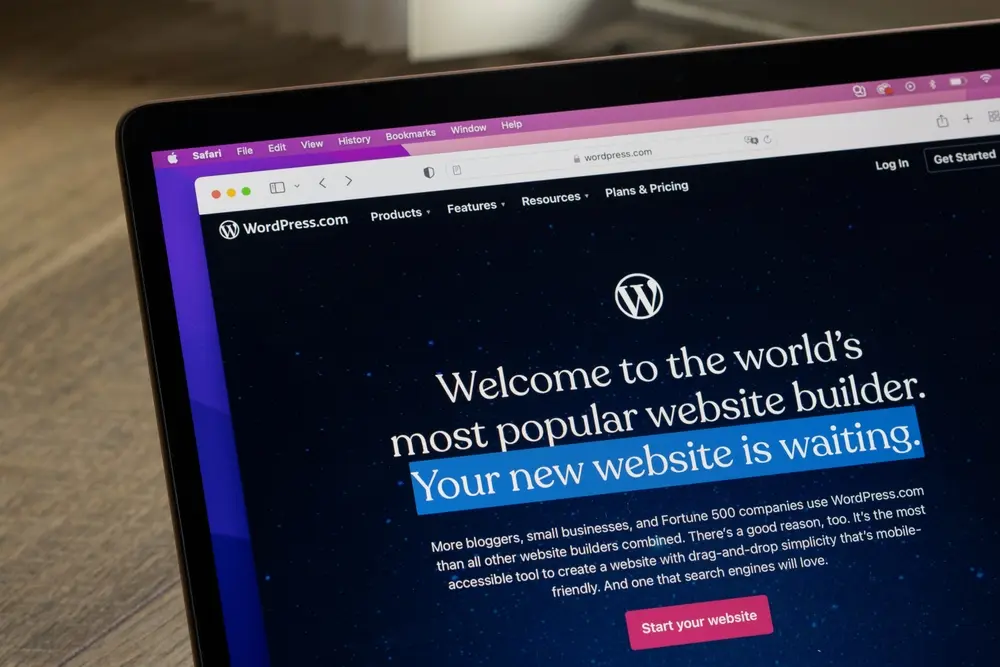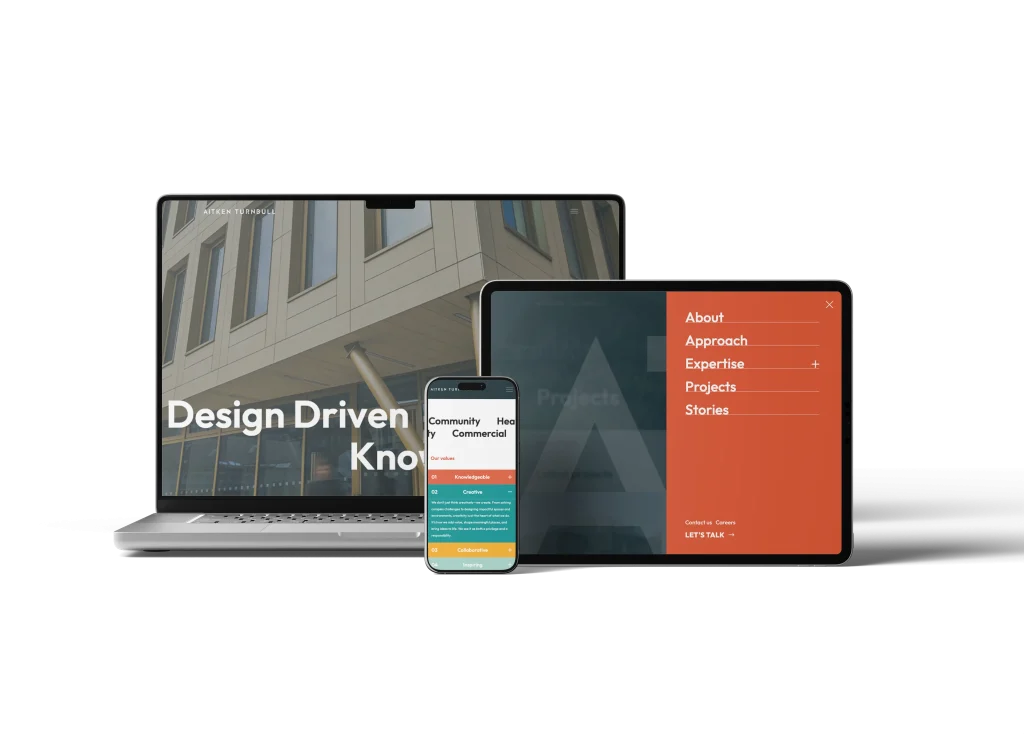Creating a new website or upgrading an existing one comes with a lot of questions. From choosing the right tools to understanding the cost, having clear, reliable answers is the first step toward a successful online presence. This website development FAQ article covers the most common questions you may have and the answers to help you make informed decisions.
What is the best CMS for a website?
There is no single “best” Content Management System (CMS); the best choice depends entirely on your specific needs, budget, and technical skill level.

- For Customisation and Flexibility (our recommendation): WordPress is the world’s most popular CMS, powering over 40% of websites globally. Known for its vast library of plugins and themes. It offers unmatched flexibility for nearly any type of site, from simple blogs to complex e-commerce stores. It’s easy to use and keep your website up to date without needing to use an agency or developer for most content-related amendments.
- For E-commerce: Shopify is often considered the best for dedicated online stores due to its robust e-commerce features and ease of use. For businesses looking for more complex integrations and systems, we’d recommend using Woo (formerly WooCommerce).
- For Ease of Use/Beginners: Wix and Squarespace are excellent website builders that offer user-friendly, drag-and-drop interfaces with built-in hosting. These websites are a good option for people like bloggers who want to increase subscribers or tradesmen looking to generate more enquiries, but they offer limited opportunities to scale and integrate.
- For Large-Scale Projects and Systems: One of the best emerging options for large-scale bespoke projects is using Laravel. The most common option in the past may have been to use an open-source CMS like Drupal, but this requires experienced and often specialist development to build and edit. Laravel is compatible with WordPress to enable complex systems to co-exist with an easy-to-use CMS.
What is the difference between template and bespoke websites?
The difference lies in control, uniqueness, and cost.

| Feature | Template Website | Bespoke Website |
| Foundation | Uses a pre-designed layout or theme. | Designed and coded from scratch, specifically for you. |
| Cost | Generally much cheaper (lower upfront investment). | More expensive (significant upfront investment). |
| Build Time | Faster to launch. | Slower and more involved build process. |
| Uniqueness | Design may look similar to other sites using the same template. | Completely unique design and functionality. |
| Scalability | Can be limiting for future growth or complex features. | Highly scalable and can evolve with your business needs. |
A template website is ideal for quick launches and small budgets, whereas a bespoke website is an investment that provides a unique brand experience, better performance, and long-term scalability.
Based on our experience, bespoke websites represent a better value investment. Template websites tend to have a lifespan if the business is growing at a fast rate. Bespoke websites grow with you, allowing for updates to be made to the brand, content and style, rather than just starting from scratch.
Explore our bespoke web development services if you’d like to see what’s possible.
How much does a website cost?
Website costs can range from less than £100 per year for a basic, DIY site to tens of thousands of pounds for a complex, bespoke web design and development solution.

The cost is typically divided into three categories:
- Initial Build/Design:
- DIY Website Builder (e.g., Wix, Squarespace): Free to approximately £100 – £500 per year (including platform subscription).
- Professional Template Build (e.g., WordPress with a theme): £500 – £10,000 for design and setup, plus ongoing hosting.
- Bespoke Web Design: £10,000 – £50,000+ depending on complexity, functionality, and agency size.
- Hosting & Domain:
- Domain Name: Approximately £10 – £50 per year.
- Web Hosting: Ranging from £5 – £250+ per month, depending on the type (shared, VPS, dedicated) and traffic volume.
- Ongoing Maintenance:
- CMS Updates, Security, Content Changes: Can be done in-house or outsourced for £100 – £500+ per month, depending on service level.
The average price for a bespoke WordPress website is between £15,000 and £30,000, depending on size, complexity, integrations, and region.
Web design companies in London, for example, will cost considerably more than web design companies in the Midlands.
How to migrate to a new website?
A successful website migration is a multi-step process that prioritises retaining your search engine ranking (SEO) and user experience. 301 redirects are the most critical step.

- Define a Plan & Goal: Clearly outline what is changing (domain, CMS, design, structure) and what success looks like (e.g., maintain organic traffic).
- Crawl the Old Site: Create a complete list of all current URLs on your old website. This is your “source” list.
- Map URLs (The Critical Step): Create a 301 Redirect Map. This spreadsheet maps every single old URL to its new, corresponding URL. A 301 permanent redirect tells search engines the content has moved permanently and transfers the SEO value (link equity).
- Test the New Site: Ensure all content, functionality, and internal links work correctly on the new platform/staging environment before going live.
- Launch & Implement Redirects: Go live with the new site and immediately implement all the 301 redirects from the map on your old server.
- Verify Post-Launch: Use tools like Google Search Console to submit the new sitemap, check for crawl errors, and monitor traffic for any drops in performance. Monitor the redirect chains to ensure they are working properly.
What is an SSL certificate, and do I need one?
An SSL (Secure Sockets Layer) certificate is a digital certificate that authenticates a website’s identity and enables an encrypted connection (HTTPS) between a user’s browser and your server.

Yes, you absolutely need one. It is critical for:
- Security: It protects user data (like login or payment information) from interception.
- Trust: It displays a padlock icon in the browser, signaling to users that the site is safe.
- SEO: Google uses HTTPS as a minor ranking factor, and most modern browsers display a prominent “Not Secure” warning on sites without one.
Why is my website slow, and how can I fix it?
A slow website is most often caused by unoptimised, large files (especially images) or a slow hosting server.
The most common culprits and fixes are:
| Culprit | Cause | Solution |
| Oversized Images | High-resolution images not compressed or resized for the web. | Compress and optimise all images (we recommend using a tool like Squoosh to convert to Webp files), and use lazy loading. |
| Poor Hosting | Sharing server resources with too many other sites (cheap shared hosting). | Upgrade your hosting plan (e.g., to a VPS or dedicated server) or switch providers. |
| No Caching | The server has to rebuild the page from scratch for every visitor. | Implement a caching plugin (for CMS like WordPress) or use a CDN (Content Delivery Network). |
| Too Many Scripts | Excessive use of third-party plugins, custom code, or unminified JavaScript/CSS files. | Delete unnecessary plugins and minify (compress) your code files. |
What is SEO and how do I get my website on Google?
SEO stands for Search Engine Optimisation, which is the practice of increasing the quantity and quality of traffic to your website through organic (non-paid) search engine results.

To get your website indexed and start ranking on Google, you must follow these steps:
- Technical Check: Ensure your site is crawlable (Google’s bots can read it) and indexable (Google is allowed to show it) by submitting an XML Sitemap to Google Search Console.
- Content Quality: Create unique, high-quality, and informative content that directly answers your audience’s questions (like this FAQ).
- Mobile-Friendly Design: Ensure your website has a responsive design that works perfectly on all screen sizes, as Google primarily uses the mobile version of your site for ranking (Mobile-First Indexing).
What is Website Maintenance?
Website maintenance is the ongoing process of checking your website for issues and errors, and keeping it updated, optimised, and secure.
It’s the digital equivalent of a service and MOT on your car. You wouldn’t drive a car for years without maintenance, and your website, which is your 24/7 business asset, is no different.
Key maintenance tasks include:
| Category | Typical Tasks | Why It’s Done |
| Security | Applying software and security patches (for CMS, themes, and plugins); running malware scans. | To block hackers from exploiting vulnerabilities and prevent data breaches. |
| Performance | Optimising images, clearing cache, fixing broken links (404 errors), and checking page load speed. | To ensure the site loads fast and runs smoothly, keeping visitors from leaving prematurely. |
| Functionality | Testing all forms, checkout pages, and interactive features; checking mobile-responsiveness. | To ensure every part of your site works as intended so you don’t lose sales or leads. |
| Data Protection | Performing and verifying regular, off-site backups of the entire website. | To allow for a quick recovery if the site is hacked, crashes, or a critical error occurs. |
| Content/SEO | Reviewing and updating old content for accuracy and relevance. | To keep your site fresh for visitors and to boost your rankings in search engines. |
Every website, regardless of size or purpose (from a small blog to a large e-commerce store), requires ongoing maintenance. The risks of neglecting it far outweigh the cost or effort of maintenance. You can either do this in-house or have an external agency complete it for you.
Have more questions about web development?
If we haven’t answered your questions above, then please don’t hesitate to drop us a message or book a meeting to find out more about our web design and development services.



 Begin
Begin Details
Details Project
Project Uploads
Uploads







